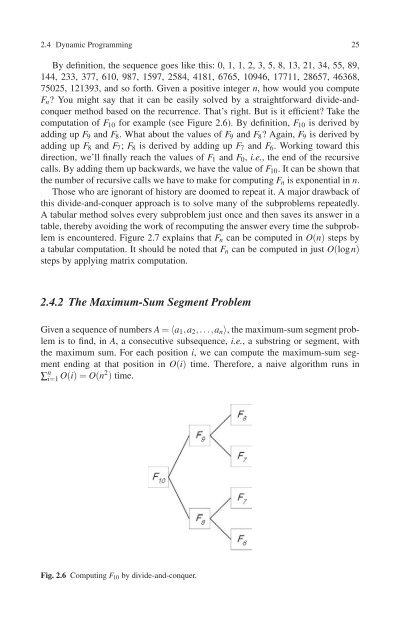You also want an ePaper? Increase the reach of your titles
YUMPU automatically turns print PDFs into web optimized ePapers that Google loves.
2.4 Dynamic Programming 25<br />
By definition, the sequence goes like this: 0, 1, 1, 2, 3, 5, 8, 13, 21, 34, 55, 89,<br />
144, 233, 377, 610, 987, 1597, 2584, 4181, 6765, 10946, 17711, 28657, 46368,<br />
75025, 121393, and so forth. Given a positive integer n, how would you compute<br />
F n ? You might say that it can be easily solved by a straightforward divide-andconquer<br />
method based on the recurrence. That’s right. But is it efficient? Take the<br />
computation of F 10 for example (see Figure 2.6). By definition, F 10 is derived by<br />
adding up F 9 and F 8 . What about the values of F 9 and F 8 ?Again,F 9 is derived by<br />
adding up F 8 and F 7 ; F 8 is derived by adding up F 7 and F 6 . Working toward this<br />
direction, we’ll finally reach the values of F 1 and F 0 , i.e., the end of the recursive<br />
calls. By adding them up backwards, we have the value of F 10 . It can be shown that<br />
the number of recursive calls we have to make for computing F n is exponential in n.<br />
Those who are ignorant of history are doomed to repeat it. A major drawback of<br />
this divide-and-conquer approach is to solve many of the subproblems repeatedly.<br />
A tabular method solves every subproblem just once and then saves its answer in a<br />
table, thereby avoiding the work of recomputing the answer every time the subproblem<br />
is encountered. Figure 2.7 explains that F n can be computed in O(n) steps by<br />
a tabular computation. It should be noted that F n can be computed in just O(logn)<br />
steps by applying matrix computation.<br />
2.4.2 The Maximum-Sum Segment Problem<br />
Given a sequence of numbers A = 〈a 1 ,a 2 ,...,a n 〉, the maximum-sum segment problem<br />
is to find, in A, a consecutive subsequence, i.e., a substring or segment, with<br />
the maximum sum. For each position i, we can compute the maximum-sum segment<br />
ending at that position in O(i) time. Therefore, a naive algorithm runs in<br />
∑ n i=1 O(i)=O(n2 ) time.<br />
Fig. 2.6 Computing F 10 by divide-and-conquer.

















